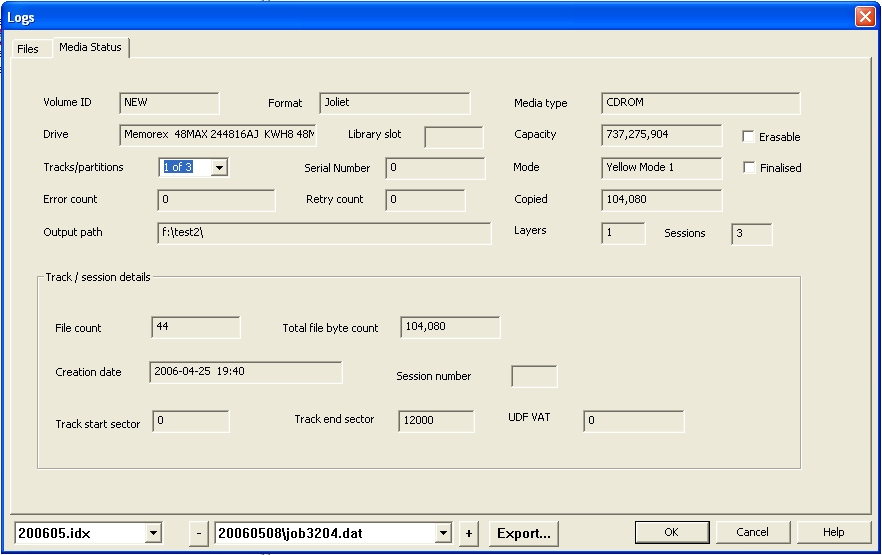|
Job details
|   |
The job details are obtained by clicking on the Media Status tag. This screen will give details of the media, and the job that are fixed for the media, rather than individual file details.
The screen is universal for all types of media, so not very field will be filled in for every media type.

Volume ID
This is the name read from the media. It is normally user entered when the media is formatted, or for a CD, when it is burnt.
Format
This is the logical format, or operating system. One will expect values such as NTFS, FAT32, UDF.
Media Type
This is the physical media. Values such as CDROM, Floppy, and Hard drive will be seen. It is very difficult to distinguish between a hard drive and a flash memory chip, so they described as Removable drive.
Drive
This provides details of the physical drive being used to read the media. For forensic inquiries this can be important. When reading a hard drive, the details stored here are those of the drive.
Library Slot
The library slot value is only used when media (eg CDs) are being read from a random access library.
Capacity
The capacity is the raw capacity of the media, displayed in bytes. This does not define the amount of information on the media, and when compression is used, the data stored can exceed the stated capacity.
Erasable
The erasable flag is only relevant for CDs and DVDs. If set, then the media is RW (Read/Write) rather than write once.
Tracks partitions
Many types of media can be divided into logical smaller sections. For a hard drive, they can be partitioned so that they behave like completely separate drives. For CDs, the disk can be written as separate tracks. For audio CDs, this is used for separate songs etc. With data CDs, tracks are normally an indication that the CD has been written more than once, as a multi-session CD. However, it should be noted that a single session may contain multiple tracks, though typically, tracks and sessions map one to one to each other.
Serial Number
Many pieces of media have a unique serial number, added at creation time, or first initialisation. This is not normally user changeable.
Mode
CDs can be written in several different physical ways. Although these are largely invisible to any user, they can affect compatibility. The options that are recognised are
CD Audio
Yellow Mode 1
Yellow Mode 2
XA Mode 2, form 1
XA Mode 2 form 2
Finalised
CDs can be appended to or have contents fixed. When fixed, the session is finalised, or closed and no additional sessions may be added.
Error Count
This is the number of errors detected when reading the media. Many disks can be read very successfully with several errors, but problems can occur when the error count goes into hundreds
Retry Count
This is the number of times the drive has to retry to read a sector. A large number of retries, and a small error count indicates a drive that is failing, media that has problems, or a drive media combination that is not very compatible, or misaligned.
Copied
Output Path
The output path is where the files have been copied to. At times, depending on recovery mode, the output path may be appended with fixed directories such as !recover or !deleted.
Layers
Layers is for DVDs only. Some DVDs have 2 layers - and hence a capacity of about 9GB a side.
Sessions
For CDs there can be multiple sessions of writing. Typically each session on a data CD will be a new track, but there is no reason why sessions should not contain more than one track.